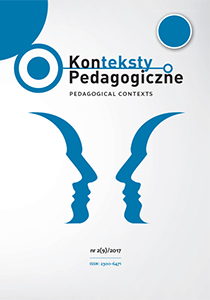Abstrakt
Edukacja włączająca niesie ze sobą pozytywne przesłanie pedagogiki humanistycznej, równych szans i autorealizacji zarówno dla osób zagrożonych wykluczeniem, jak i pozostałych. Wdrażanie jej podstawowych założeń jest obecnie zalecane przez Komisję Europejską. Przeprowadzone badanie ujawnia niespójność pomiędzy tradycyjnymi wartościami społecznymi, takimi jak miłosierdzie i współczucie z jednej strony, a odzwierciedleniem tychże ideałów w rzeczywistości z drugiej. Zderzenie wartości humanistycznych i kompetencji, a także kwestie organizacyjne przeszkadzają bowiem w pełnej akceptacji edukacji włączającej. Przedstawione badania opierają się głównie na badaniach ankietowych przeprowadzonych w rosyjskim środowisku edukacyjnym.
Bibliografia
Ainscow, M. & César, M. (2006). Inclusive Education Ten Years after Salamanca: Setting the Agenda. European Journal of Psychology of Education, 21(3), 231–238.
Ainscow, M. & Miles, S. (2008). Making Education for All Inclusive: Where Next?. Prospects, 38(1), 15–34.
Avramidis, E., Bayliss, P. & Burden, R. (2002). Inclusion in Action: An inDepth Case Study of an Effective Inclusive Secondary School in the SouthWest of England. International Journal of Inclusive Education, 6(2), 143–163.
Booth, T. & Ainscow, M. (2011). Index for Inclusion: Developing Learning and Partici-pation in Schools. Bristol: CSIE.
Brandon, T. & Charlton, J. (2011). The lessons learned from developing an inclusive learning and teaching community of practice. International Journal of Inclusive Edu-cation, 15(1), 165–178.
Carroll, D. et al. (2011). School Culture for Students with Significant Support Needs: Belonging Is Not Enough. International Journal of Special Education, 26(2), 1–9.
Carter, E., Hughes, C., Gutt, C. & Copeland, S. (2005). Factors Influencing Social Interaction Among High School Students With Intellectual Disabilities and Their General Education Peers. American Journal on Mental Retardation, 110(5), 366–377.
Convention on the Rights of Persons with Disabilities and Optional Protocol. Resolution Adopted by the General Assembly, 2007. Vol. A/RES/61/1.
Ellins, J. & Porter, J. (2005). Departmental Differences in Attitudes to Special Educational Needs in the Secondary School. British Journal of Special Education, 32(4), 188–195.
Federal Law «On education in the Russian Federation», adopted 24.07.2015.
Graham, L. & Harwood, V. (2011). Developing Capabilities for Social Inclusion: Engaging Diversity through Inclusive School Communities. International Journal of Inclusive Education, 15(1), 135–152.
Hilt, L. (2015). Included as excluded and excluded as included: minority language pupils in Norwegian inclusion policy. International Journal of Inclusive Education, 19(2), 165–182.
Hotulainen, A. & Takala, M. (2014). Parents’ views on the success of integration of students with special education needs. International Journal of Inclusive Education, 18(2), 140–154.
Humphrey, N. & Symes, W. (2010). Perceptions of Social Support and Experience of Bullying among Pupils with Autistic Spectrum Disorders in Mainstream Secondary Schools. European Journal of Special Needs Education, 25(1), 77–91.
Kane, J. & Cogan, N. (2011). Towards Inclusion? Models of Behaviour Support in Secondary Schools in One Education Authority in Scotland. British Journal of Spe-cial Education, 31(2), 68–74.
Lambert, R. (2015). When I am being rushed it slows down my brain: constructing selfunderstandings as a mathematics learner. International Journal of Inclusive Edu-cation, http://dx.doi.org/10.1080/13603116.2016.1251978 [accessed: 05.12.2016].
McDougall, J. et al. (2004). High SchoolAged Youths’ Attitudes toward Their Peers with Disabilities: The Role of School and Student Interpersonal Factors. Interna-tional Journal of Disability, Development and Education, 51(3), 287–313.
Messiou, K. (2016). Research in the field of inclusive education: time for a rethink?. International Journal of Inclusive Education, http://dx.doi.org/10.1080/13603116.2016.1223184 [accessed: 09.12.2016].
Naraian, S. (2016). Inclusive education complexly defined for teacher preparation: the significance and uses of error. International Journal of Inclusive Education, http://www.tandfonline.com.scihub.io/doi/full/10.1080/13603116.2015.1134682?scroll=top&needAccess=true [accessed: 19.12.2016].
Olav, M. (2007). Diverging Paths in Upper Secondary Education: Competence Attainment among Students with Special Educational Needs. International Journal of Inclusive Education, 11(2), 215–231.
Osberg, D. & Biesta, G. (2010). The end/s of education: complexity and the conundrum of the inclusive educational curriculum. International Journal of Inclusive Education, 14(6), 593–607.
Paliokosta, P. & Blandford, S. (2010). Inclusion in School: A Policy, Ideology or Lived Experience? Similar Findings in Diverse School Cultures. Support for Learning, 25(4), 2247–2253.
Petriwskyj, A. (2010). Diversity and inclusion in the early years. International Journal of Inclusive Education, 14(2), 195–212.
Strogilos, V. (2012). The cultural understanding of inclusion and its development within a centralized system. International Journal of Inclusive Education, 16(12), 1241–1258. Vroey, A., Struyf, E. & Petry, K. (2016). Secondary school included: a literature review. International Journal of Inclusive Education, 20(2), 109–135.
Waldron, N., Cole, C. & Majd, M. (2001). The academic progress of students across in-clusive and traditional settings: A two year study Indiana inclusion study. Bloomington, IN: Indiana Institute on Disability and Community.
Whitbread, K. (2005). What Does Research Say About Inclusive Education?, http://www.wrightslaw.com/info/lre.incls.rsrch.whitbread.htm [accessed: 03.10.2016].
Wong, D. (2008). Do Contacts Make a Difference? The Effects of Mainstreaming on Student Attitudes toward People with Disabilities. Research in Developmental Dis-abilities, 29(1), 70–82.
Autor zgodnie z zaleceniem MNiSW, by przeciwdziałać praktykom „ghostwriting” i „guest authorship” składając tekst dołącza oświadczenie Autora/Autorów, w którym deklaruje wkład każdego z Autorów w powstawanie publikacji. Własnoręcznie podpisane oświadczenie należy przesłać na adres redakcji:
Joanna Skibska | w formie skanu przesłać poprzez system OJS (biblioteka wydawcy).
Autorzy nie ponoszą żadnych kosztów w związku z publikacją artykułu na łamach czasopisma Konteksty Pedagogiczne oraz nie otrzymują gratyfikacji finansowej za opublikowanie tekstu. Redakcja zastrzega sobie prawo do wprowadzania niewielkich zmian w artykułach, które nie mają wpływu na merytoryczną stronę publikacji.
Autor (Autorzy) artykułu oświadcza, że przesłane opracowanie nie narusza praw autorskich osób trzecich. Wyraża zgodę na poddanie artykułu procedurze recenzji oraz dokonanie zmian redakcyjnych. Przenosi nieodpłatnie na Wydawnictwo Libron autorskie prawa majątkowe do utworu na polach eksploatacji wymienionych w art. 50 Ustawy z dnia 4 lutego 1994 r. o prawie autorskim i prawach pokrewnych – pod warunkiem, że praca została zaakceptowana do publikacji i opublikowana.
Wydawnictwo Libron posiada autorskie prawa majątkowe do wszystkich treści czasopisma. Zamieszczenie tekstu artykuły w repozytorium, na stronie domowej autora lub na innej stronie jest dozwolone o ile nie wiąże się z pozyskiwaniem korzyści majątkowych, a tekst wyposażony będzie w informacje źródłowe (w tym również tytuł, rok, numer i adres internetowy czasopisma).
Tekst jest udostępniany w internecie na licencji CC-BY-SA

